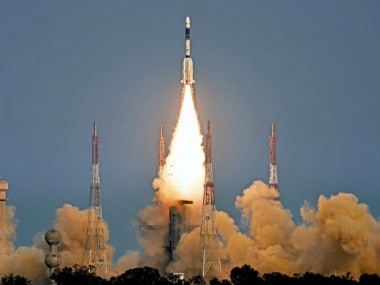A day after the Indian Space Research Organisation's (ISRO) latest communication satellite went incommunicado in space, officials said on Sunday that efforts to restore links with the satellite are currently underway.
Launched on 29 March, GSAT-6A was to be India’s largest communications satellite yet, carrying a 6-metre antenna for enabling more efficient ground communication.
A satellite is placed in orbit in three phases. The second orbit raising operation of GSAT-6A was successfully carried out on Saturday, but when it was on course for the third and final firing scheduled for Sunday, communication with the satellite was lost, the space agency said, hours after maintaining uncharacteristic silence on the health of the satellite.
ISRO Chairman K Sivan told PTI that preliminary data shows there are chances of recovery, but establishing link with the satellite was the key. "After the second manoeuvre when the satellite was in the 'normal' mode, suddenly the link was cut... now we are trying to establish the link. Mission Control is on the job continuously," he said.
The satellite goes into a "safe mode" when such disturbances in communication arise, which is when ground control reestablishes the link and puts the satellite back into orbit, the ISRO chief explained. "But now we are not able to link, and that process is going on," he said.

The launch of the GSLV-F08 on 29 March. Image courtesy: ISRO
Speaking on the condition of anonymity, a former senior ISRO official told Firstpost that one should not lose hope yet. "If I understand correctly, it is a power supply anomaly that is preventing re-establishment of contact. Once you achieve first contact, it is possible to get the satellite back into working condition using several 'Plan-B' mechanisms. So things, as they stand now, depend on the initial connection to the satellite," he said.
"Why the satellite did not go into safe-mode is a matter of investigation for later. Speculation will not help anybody right now."
This setback might push the scheduled launches of other satellites behind, a report in The Economic Times said. "If we don’t succeed to re-establish contact with the satellite, the mission is declared dead. An inquiry will attempt to find the root cause of the snag. Also, there will be much more stringent quality checks now so that similar incidents doesn’t repeat," the report quoted an ISRO scientist as saying. "This means there will be delay in building other satellites."
However, an NDTV report said that future launches will remain unaffected. ISRO's next launch is tentatively scheduled for 12 April, which is when the Polar Satellite Launch Vehicle (PSLV) is slotted to take off. Around 10 launches, including the GSAT-7A, Cartosat-3, Oceansat-3 and Chandrayaan-2 are also planned.
The 2,140-kg GSAT-6A rode piggyback on ISRO's powerful geosynchronous rocket (GSLV-F08) fitted with indigenous cryogenic engine at the third stage and was put into orbit successfully after the launch in what was described by a senior ISRO official as a "magnificent mission".
GSAT-6A, with a mission life of about 10 years, is designed to provide a thrust to mobile communication through its multi-beam coverage facility. It will also help in mobile communication even from remote locations through hand-held ground terminals, and is considered a shot in the arm for the military.
The satellite is also aimed at providing a platform for developing technologies such as demonstration of 6 metre S-Band Unfurlable Antenna, hand-held ground terminals and network management techniques that could be useful in satellite-based mobile communication applications. "GSAT-6A is a complement to GSAT-6, which is already in orbit. These two satellites, combined, will provide a platform for development of advanced technologies," Sivan had said post the launch.
This was the first mission under the chairmanship of Sivan, who assumed charge of the space agency in January. In August 2017, India's mission to launch its backup navigation satellite IRNSS-1H on board PSLV-C39 ended in a failure after a technical fault on the final leg following a perfect launch.
ISRO had then said the heat shield had not separated on the final leg of the launch sequence and, as a result, IRNSS-1H had got stuck in the fourth stage of the rocket.
With inputs from PTI
Published Date: Apr 02, 2018 09:34 AM | Updated Date: Apr 02, 2018 09:38 AM
No comments:
Post a Comment